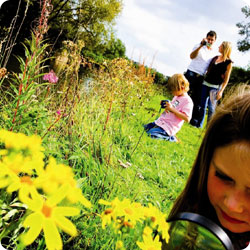- home ›
- features & articles ›
- features ›
- wildlife
Wildlife
Wildlife
You'll find all sorts of wildlife on Britain's waterways - from common sights such as mallards and moorhens, to otters and water voles.
You can help waterway ecologists.
Every year British Waterways runs a national wildlife survey, inviting members of the public to report what they have spotted on Britain's canals and rivers.
Read the results of the Wildlife Survey 2011
Find out how British Waterways supports waterway wildlife
Last updated: 16/11/2011
In this section ...
-
 Kingfisher »
Kingfisher »The 'King of Fishers' is usually glimpsed as a sudden flash of glistening blue. More »
-

-
 Barn Owl »
Barn Owl »The much loved barn owl is most often seen at night in the countryside along riverbanks, towpaths, field hedgerows and roadsides, where it hunts for prey. More »
-

-
 Bumblebee »
Bumblebee »Bumblebees are among the most endearing and familiar of our insects. The sight and sound of bees droning methodically from flower to flower is a quintessential part of a summer’s day. Sadly, however, changes to the farmed countryside have not been kind to our bumblebees More »
-
 Butterfly »
Butterfly »The UK glories in more than 50 different species of this brightly coloured insect. Sadly though, a study by the Natural Environment Research Council in 2004 found a species decline of 71% between 1983 and 2003. Several UK species are now listed in the UK Biodiversity Action Plan (BAP). More »
-

-
 Canada Goose »
Canada Goose »The Canada Goose is one of the most recognised geese in the UK and is notorious for the loud honking noise that it makes. More »
-
 Common toad »
Common toad »Our common toad is the largest toad found in Europe. More »
-

-
 Cormorant »
Cormorant »These prehistoric-looking fisherman have become an increasingly common sight along inland lakes and waterways in the UK. More »
-
 Crayfish »
Crayfish »Crayfish populations are thriving in Britain's waterways. More »
-
 Damselfly »
Damselfly »Damselflies are brightly coloured insects who, like dragonflies, are acrobatic masters of the air, hunting for their prey which consists mainly of mosquitoes, midges and larger insects. More »
-
 Dragonfly »
Dragonfly »Dragonflies are the raptors of the insect world. More »
-

-

-
 Grasshopper »
Grasshopper »These all-singing, all-dancing creatures truly are the gymnasts of the insect world, being able to leap distances of up to 20 times the length of their own body! More »
-
 Grass snake »
Grass snake »Britain's largest reptile is shy by nature and wary of humans. More »
-
 Grey Squirrel »
Grey Squirrel »Sighted throughout the year, the grey squirrel is at its busiest in Autumn. More »
-

-
 Hedgehog »
Hedgehog »This small spiny mammal has changed little over the last 15 million years. More »
-

-

-
 House Sparrow »
House Sparrow »The house sparrow is a gregarious bird, happy to live in colonies close to human habitation. More »
-

-
 Ladybird »
Ladybird »Ladybirds are brightly coloured beetles that range in size from 1 – 10mm long. The 2 spot and larger 7 spot ladybirds are the commonest species, although around 46 different species can be found in Britain alone. More »
-

-

-

-

-

-

-

-
 Pearl mussels »
Pearl mussels »The luminous pearls which attracted Julius Ceaser to Britain are now dangerously rare. More »
-
 Pond Skater »
Pond Skater »Pond skaters are thin, brown or grey insects that float on the surface of ponds and still waters hunting for prey. More »
-

-

-

-
 Spring wildlife »
Spring wildlife »March 21st is celebrated as the first day of spring and the end of dreary winter. However, Mother Nature pays no heed to calendars and the first signs of the changing seasons can often be glimpsed as early as January. More »
-
 Starling »
Starling »Starlings can be seen throughout the UK and at all times during the year. They like to spend the winter here and many thousands migrate here during the autumn. More »
-

-
 Summer wildlife »
Summer wildlife »Summer is a time of abundance, colour and life - an especially busy season for wildlife. More »
-

-
 Terrapin »
Terrapin »Originally native to the UK some 8,000 years ago, the terrapin has made a fateful return to our waterways in the aftermath of 1980s 'turtle mania'. More »
-
 Waterboatman »
Waterboatman »These small, brown insects tend to dwell at the bottom of ponds, lakes and slow-moving canals and rivers, only coming to the surface for air. More »
-
 Water vole »
Water vole »Best known as 'Ratty' from Wind in the Willows, the furry water vole is an endearing waterways character. More »



